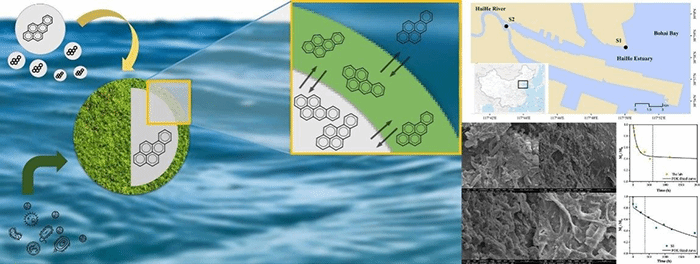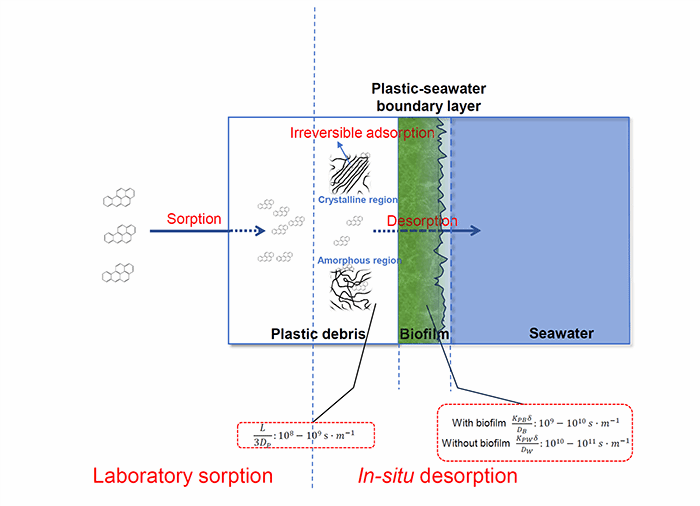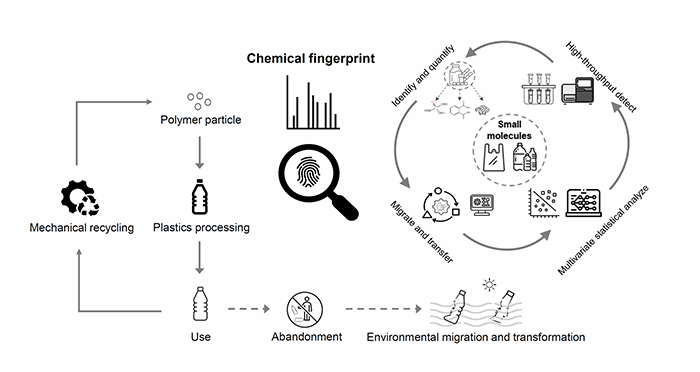Release time:2025-06-24
Recently, the Coastal Environmental Safety Laboratory of Tianjin University’s School of Marine Science and Technology has made significant progress in the field of marine microplastic and organic pollutant co-contamination, with related findings published in high-level international environmental journals: "Marine Pollution Bulletin" (JCR Q1, IF 2023 = 5.3), "Environmental Pollution" (JCR Q1, IF 2024 = 7.3), and "Eco-Environment & Health" (JCR Q1, IF 2024 = 17.6).
Microplastics (MPs) can serve as carriers for hydrophobic organic compounds (HOCs) to migrate in aquatic environments; however, the impact of biofilms colonizing plastic surfaces on the fate of HOCs within MPs in real environments remains unclear. Based on this, the research team deployed pristine polyethylene (PE) particles pre-adsorbed with benzo[a]pyrene (BaP) in situ at the Hai River estuary in Bohai Bay for 80 days to study their desorption behavior. Through laboratory and in situ experiments, it was verified that under different environmental conditions, internal diffusion was the rate-limiting step in the desorption process of BaP from 2 mm diameter spherical PE-MPs. The biofilm may play a crucial role in the desorption process by hindering desorption and altering the surface properties of the microplastics, leading to a noticeable lag in the in situ desorption process within the timescale of this study. Additionally, the research indicated that the microorganisms within the biofilm have potential degradation capabilities for PE and BaP, which drive the ongoing desorption of BaP. This study reveals the interaction between biofilms and MPs-HOCs and their influence on the environmental behavior of HOCs.

Figure 1: Study on the influence of biofilm on the desorption process of hydrophobic organic compounds from microplastics
To further investigate the impact of biofilms on the desorption of microplastic composite pollutants and the kinetics of desorption in seawater environments, the research team deployed polyethylene (PE) sheets pre-adsorbed with different concentrations of the non-polar pollutant, benzo[a]pyrene (BaP), in situ at the Hai River estuary to study desorption kinetics under natural biofilm colonization conditions. Based on the desorption kinetics of BaP from the PE sheets, a mass transfer model was constructed to describe the desorption process of non-polar pollutants from PE under the influence of biofilm formation. The research demonstrated that biofilms, acting as an intermediary between plastics and aquatic environments, did not serve as a sink for BaP adsorbed in plastics. Instead, they altered the mass transfer process of BaP at the boundary layer by reducing the distribution coefficient of BaP between the plastic and boundary layer. Furthermore, based on the diffusion mass transfer model developed by the team, predictions were made regarding the impacts of biofilms on the fate of other non-polar and weakly polar pollutants in PE. This study emphasizes the influence of biofilms on the desorption of hydrophobic pollutants from plastics in real environments and provides new insights into the leaching processes of additives from plastics.

Figure 2: Desorption mechanisms of hydrophobic organic compounds mediated by biofilms in microplastics
As the movement and transformation of (micro)plastics in material flow and the environment are often accompanied by changes in their macroscopic morphology and surface characteristics, it is challenging to fully understand the migration and transformation processes of (micro)plastics on a macroscopic level, increasing the difficulty of managing plastics and plastic additives. Building on previous research, the team proposed the concept of the "chemical fingerprint" of plastics, defining the characteristics (types, concentrations, and ratios) of organic small molecules related to plastics as the chemical fingerprint of plastics. This study discusses strategies and challenges for tracking plastics based on this concept. It emphasizes that the chemical fingerprint, as a unique and distinctive identifier, provides potential opportunities for tracking the entire life cycle of plastics, including processing, use, recycling, disposal, and environmental aging.

Figure 3: Opportunities and challenges of tracking strategies based on the "chemical fingerprint" of plastics
The first authors of the above studies are Hao Xiaohan, a master's student from the Class of 2023, and Liu Hongtao, a master's student from the Class of 2025, under the guidance of Professors Niu Zhiguang and Dr. Ma Yongzheng.
Reference:
1. Xiaohan Hao, Ying Zhang, Yueling Sun, Hongtao Liu, Xiaohan Zhang, Xiaofeng Li, Yongzheng Ma*, Zhiguang Niu*. Biofilms retard the desorption of benzo(a)pyrene from polyethylene pellets in the marine environment. Marine Pollution Bulletin, 2023, 195: 115453.
//doi.org/10.1016/j.marpolbul.2023.115453
2. Hongtao Liu, Yongzheng Ma*, Jingen Xiao, Ying Zhang, Yuan Li, Ao Shen, Zhiguang Niu, Qiqing Chen, Baizhu Chen. Biofilm-mediated mass transfer of sorbed benzo[a]pyrene from polyethylene to seawater, Environmental Pollution, 2025, 374: 126257.
//doi.org/10.1016/j.envpol.2025.126257
3. Hongtao Liu, Yuna Li, Yongzheng Ma*, Zhiguang Niu, Ying Zhang. Plastics Tracking Strategy: Plastic-related Small Molecules as Chemical Fingerprints. Eco-Environment & Health, 2025, 4(2): 100149.